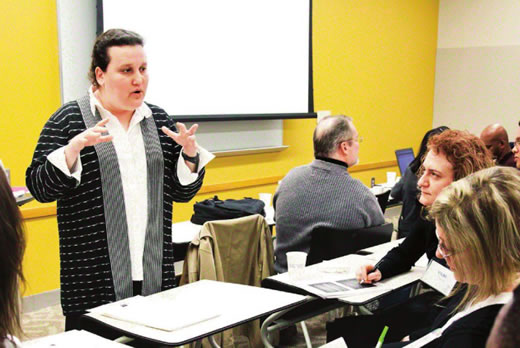By day, they are state and county health directors, policy advisers, food inspectors, IT experts, veterinarians, nurses, and physicians, among many others. By night, on weekends, and even during lunch breaks, they are students in the Career Master of Public Health (CMPH) program, one of a few of its kind in the country.
Marking 15 years of distance learning and some 250 alumni at the Rollins School of Public Health this year, the CMPH program attracts public health professionals from all over the country, as well as Canada, Africa, and Europe. In fall 2011, 65 new students enrolled — a record number. CMPH students earn the same MPH degree as traditional students but in an online format, allowing them to maintain their work schedules while applying what they learn on the job.
The program grew from the smaller Graduate Certificate Program at Emory (GCPE), developed by CDC to further train public health professionals. The intent all along was for the GCPE to become a full degree program. Students in the GCPE, along with students from graduate certificate programs at other schools, had the option of continuing on for a full degree.
"From the beginning, we had commitment to continue the program," says CMPH chair Melissa Alperin, among the first GCPE instructors. "While the program originally was intended for cdc employees, we quickly began to see a need beyond that."
Under the leadership of Kathy Miner, now associate dean for applied public health, the first cohort of GCPE students enrolled in 1997. Two years later, the CMPH program welcomed its first students, including Kendolyn Smith, an Atlanta pharmacist.
A new concept
Smith spent the early part of her career in pharmaceutical sales and training at AstraZeneca. She climbed the corporate ladder at a furious pace but wanted to continue her education.
"I knew that in order to advance professionally, I needed to continue with a graduate degree, but I wanted to continue working while I did it," says Smith. "Professionals want to work hard contributing to their professions but also find balance when it comes to pursing quality education to enhance their skills. The CMPH program made that possible for me."
In 1999, distance learning was still a new concept to many institutions.
"When I joined the program, I remember feeling that it was amazing to be part of this first group," says Smith, who now has a doctorate of pharmacy and works in Atlanta as a consultant pharmacist and public health educator. "The CMPH program is a trailblazer for distance learning programs. It really led the way in developing a curriculum to educate working professionals. Emory set the stage for people to value distance learning."
CMPH students meet at Rollins twice each semester, at the beginning and end of the term, on weekends. Outside of the classroom, students receive most of their instruction online. Students primarily use Blackboard to turn in assignments, view lectures, discuss coursework, and connect with faculty and classmates. Such online tools make it possible for students like Shella Farooki, a teleradiologist in Dublin, Ohio, to earn an MPH from Emory.
"I became interested in Rollins because it was the most career- and distance-friendly program, and the school was ranked No. 6 in the nation," says Farooki. "Reputation is key for me since I am using this opportunity to make a new career pathway for myself and bridge public health with radiology and clinical medicine."
While the CMPH program format is far different from how Farooki earned her undergraduate and medical degrees, she has adjusted well to distance learning.
"I love the face-to-face time on campus the best, but when we need to connect as a team for a group project, we have conference calls and communicate by group Wiki," says Farooki. "Some classes require discussion board postings, so we do that as well. Often, we have more relevant and succinct discussions online than we would in a classroom setting."
Full Story >>
